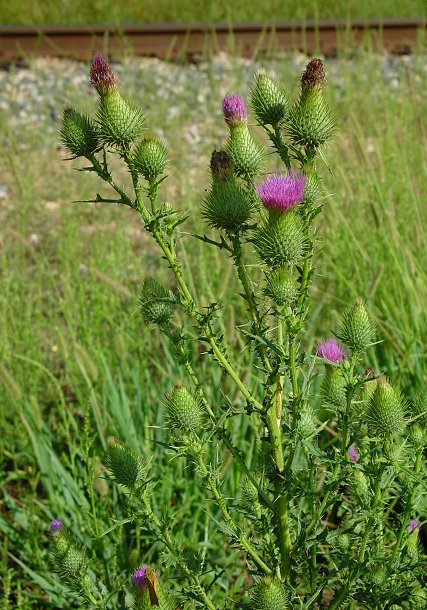Cirsium vulgare (Savi) Ten.
Bull Thistle

Introduced
CC = *
CW = 3
MOC = 27
© DETenaglia
Cirsium vulgare (Savi) Ten.Bull Thistle | |
 |
Introduced CC = * CW = 3 MOC = 27 |
© DETenaglia |
|
Family - Asteraceae/Cardueae Habit - Biennial forb, with a short, thickened taproot in addition to fibrous roots. Stems - Erect, to 2 m, branching, pubescent with cobwebby hairs, striate, at least the upper half with spiny wings (decurrent leaf tissue).
Leaves - Basal and alternate. Basal leaves 10-40 cm long, 3-15 cm wide, narrowly elliptic to oblanceolate, tapered at the base, mostly narrowly angled at the tip, with several shallow to deep lobes, the margins otherwise coarsely lobed or toothed and spiny, the upper surface appearing green, strongly roughened with numerous short, stiff bristles, not cobwebby-hairy, the undersurface finely pubescent with cobwebby hairs. Stem leaves progressively reduced from near the stem base, the main leaves 3-15 cm long, with deep, narrow lobes, slightly clasping and long-decurrent (more than 1 cm), otherwise like the basal leaves.
Inflorescence - Heads solitary or in loose clusters at the branch tips, appearing sessile or very short-stalked. Heads - Involucre 25-40 mm long, as long as or slightly longer than wide, vase-shaped, somewhat cobwebby-hairy, the lower and median bracts tapered to a spreading, spiny tip, this 2-5 mm long, straw-colored to light yellow, rarely also slightly sticky along the midrib.
Ray flowers - Absent. Disk flowers - Corollas tubular, 25-35 mm long, pink to purple, the 5 lobes 5-7 mm long. Pappus of plumose bristles 20-28 mm long, white or light tan. Style 1, exserted beyond corolla.
Fruits - Achenes 3.0-4.5 mm long. Flowering - June - September. Habitat - Forest openings, pastures, prairies, disturbed areas, roadsides, railroads. Origin - Native to Eurasia. Lookalikes - Other thistles, such as Cirsium discolor, Cirsium altissimum, etc. Other info. - This common introduced species is listed as a noxious weed in many parts of the U.S. Its appearance is similar to other thistles, especially the native C. discolor, except that the upper stems bear spiny wings extending from the leaf bases. This is probably the spiniest and most unpleasant species of thistle in the state. It is a pretty plant but doesn't make a good specimen for cultivation because of its prickles, weedy habit, and introduced status. The fruits (seeds) are carried large distances by the wind with the aid of their plumose bristles. Photographs taken in Noel, MO., 8-14-03. |